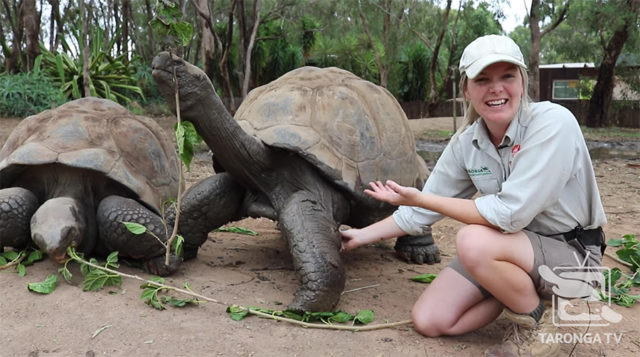Behold the renowned Galapagos tortoise, a majestic giant from Ecuador’s volcanic archipelago made famous by Charles Darwin: The Galapagos Islands.
These particular Galapagos tortoises are a long way from their native habitat. They live at the Taronga Western Plains Zoo in Dubbo Australia where Jordan Michelmore and other tortoise keepers care for these incredibly slow and long-lived species. Galapagos tortoises can live to over 150 years and weigh up to 300 kilograms (661 pounds).
Michelmore is joined by Franklin and Wilbur in the Taronga Zoo video above. In it, she discusses Galapagos tortoise shells and demonstrates how these animals keep themselves clean (with the help of finches or keepers).
In the video below, she spends time with two small six-year-old hatchlings, Galapagos tortoises Pena and Turbo.
What’s the difference between tortoises and turtles? From Britannica.com:
“All tortoises are in fact turtles—that is, they belong to the order Testudines or Chelonia, reptiles having bodies encased in a bony shell—but not all turtles are tortoises… The most important thing to remember about tortoises is that they are exclusively land creatures. They live in a variety of habitats, from deserts to wet tropical forests. (Unlike most sea turtles, which take to land only when they are laying eggs, tortoises don’t have much to do with water other than drinking it and occasionally bathing in it.) However, not all land turtles are tortoises…
One way to further distinguish tortoises from other turtles is to look for certain anatomical features. The testudinids (their family is Testudinidae) are easily recognized because all share a unique hind-limb anatomy made up of elephantine (or columnar) hind limbs and hind feet. Their forelimbs are not flipperlike, and their hind feet are not webbed. Each digit in their forefeet and hind feet contains two or fewer phalanges. Finally, if you can’t see their legs, try feeding them meat. Tortoises are generally vegetarians, while other turtles are omnivorous.”
Michelmore repeats some of the info in this NatGeo Wild clip, which features additional Galapagos tortoise footage:
Watch this next: Up close with a Giant Galapagos Tortoise.
Plus: Animals of the Galápagos archipelago in 360° 5K.
Curated, kid-friendly, independently-published. Support this mission by becoming a sustaining member today.




